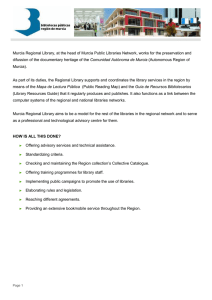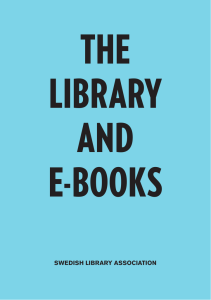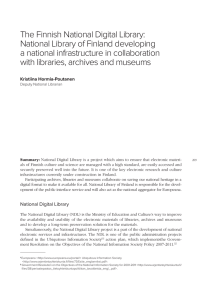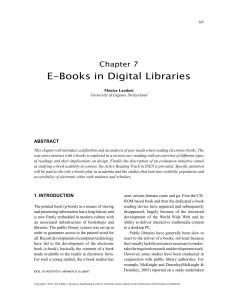Why Copyright? - Colegio de Bibliotecarios de Chile CBC
Anuncio
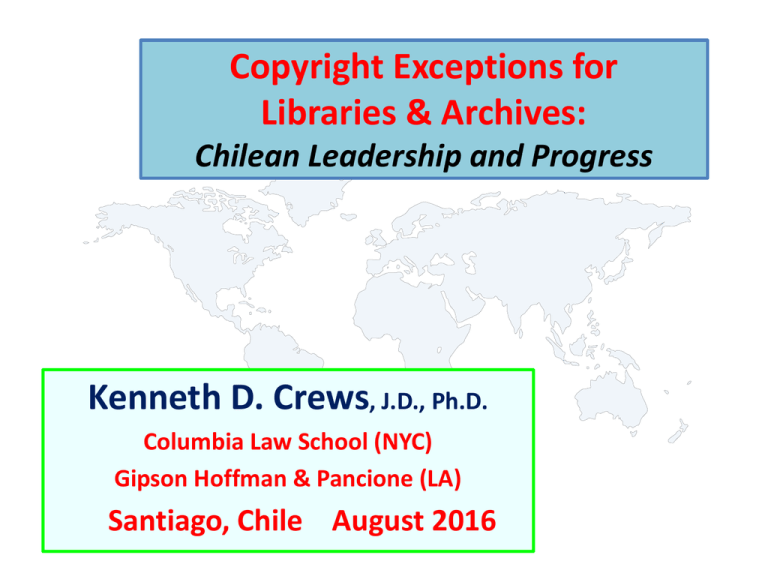
Copyright Exceptions for Libraries & Archives: Chilean Leadership and Progress Kenneth D. Crews, J.D., Ph.D. Columbia Law School (NYC) Gipson Hoffman & Pancione (LA) Santiago, Chile August 2016 Libraries and Copyright • Why Libraries and Copyright? – Legal Deposit • Published Works • Building Collections of the National Library – Libraries as Economic Catalyst • Purchasers of Books, Music, Film, and More • Licensing of Databases and Digital Collections – Libraries as Users of Copyrights • Public Lending • Reproduction and Distribution for Specific Needs The Mission • Why Copyright and Libraries? – Mission of Libraries: • To Preserve and Provide Access to Information Resources – Mission of Copyright: • To Encourage the Creation of New Works • To Encourage their Public Dissemination • To Serve Private Interests of Ownership and Public Interests of Access and Creativity A Copyright Interlude • Scope of Works – Nearly Unlimited • Automatic Copyright Protection • Long Duration – Life of the Author, plus 50 Years or More • Broad Scope of Rights – Reproduction, Distribution, and More • Risks and Penalties • Subject to Limitations and Exceptions Why Copyright? • Copyright has Expansive Scope – Works, Rights & Term of Protection • Mission of Libraries and Copyright Law – Law: To Encourage Creation and Dissemination of New Creative Works – Libraries: To Preserve and Provide Access to the Full Range of Information Resources • Many Library Activities have immediate implications for Copyright Law Berne: Three-Step Test Article 9(2): “It shall be a matter for legislation in the countries of the Union to permit the reproduction of such works in certain special cases, provided that such reproduction does not conflict with a normal exploitation of the work and does not unreasonably prejudice the legitimate interests of the author.” TRIPs Article 13: “Members shall confine limitations or exceptions to exclusive rights to certain special cases which do not conflict with a normal exploitation of the work and do not unreasonably prejudice the legitimate interests of the right holder.” Origins and Progress • WIPO Initiatives – Original Proposal, 2004 – Background Statement, 2005 – Further Proposal, 2008 – Multiple Studies, 2008 • Libraries, Blind, Education – Marrakesh Treaty, 2013 • Needs of the Visually Impaired – The Effort began with Leadership from Chile L&E Initiative 2004 November 2004: Proposal from Chile Proposal to add to the agenda “the subject of exceptions and limitations to copyright and related rights for the purposes of education, libraries and disabled persons….” The L&E Discussion The SCCR meeting in 2004 addressed: “understanding of the need to have adequate limitations, learning from existing models and moving towards agreement on exceptions and limitations for public interest purposes which, like minimum standards, were to be envisaged in all legislations for the benefit of the international community.” L&E Initiative 2005 November 2005 Proposal from Chile: • Identification of national models • Analysis of L&E to promote creativity • “Establishment of agreement on exceptions and limitations for purposes of public interest that must be envisaged as a minimum in all national legislations for the benefit of the community.” L&E Initiative 2005 November 2005 Background Statement: • “Digital technology has opened up new opportunities” • “The principle of balance is most certainly the value which best reflects the expectations of society” • “Limitations are inherent in the intellectual property system” L&E Initiative 2005 November 2005 Background Statement: • Exceptions “constitute instruments for delimiting and protecting a heritage of public property and areas of freedom for the use of knowledge and products of human creativity” • Differences among exceptions are an obstacle “for the acceptable use of works by disabled persons, libraries and public archives” L&E Initiative 2008 March 2008 Proposal from Brazil, Chile, Nicaragua, and Uruguay: • Identification of national models • Analysis of L&E to promote creativity • “Establishment of agreement on exceptions and limitations for purposes of public interest that must be envisaged as a minimum in all national legislations for the benefit of the community” L&E Initiative 2008 March 2008: WORK PLAN Proposal from Brazil, Chile, Nicaragua, and Uruguay • Research on L&E • Review of Existing L&E • Implications of Specific L&E • “prescriptive minimum global framework” • Other exceptions as “best practices” • Mandatory minimum exceptions The Studies: 2008 to 2015 SCCR 30, June 2015 Available: http://bit.ly/1GjpcGr SCCR 17, November 2008 Available: http://bit.ly/1tB8ryb SCCR 29, December 2014 Available: http://bit.ly/1A9ImgV The 2015 Study • WIPO: 188 Member Countries • Found: Statutes from all 188 Countries The 2015 Study • WIPO: 188 Member Countries • No Library Exception: 32 Countries – Significance: 156 Countries – Indicator of the Importance of Libraries • General Exception: 31 Countries – “General” Means: Exception applies to Libraries, but not to Specific Activities – Result: 125 Countries have Specific Exceptions for Libraries & Archives General Library Exception From the Tunis Model Act: “the reproduction, by photographic or similar process, by public libraries, non-commercial documentation centers, scientific institutions and educational establishments, of literary, artistic or scientific works which have already been lawfully made available to the public, provided that such reproduction and the number of copies made are limited to the needs of their activities, do not conflict with the normal exploitation of the work and do not unreasonably prejudice the legitimate interests of the author…” Scope of Exceptions • Preservation and Replacement • Private Study and Research – Making Available on the Premises • • • • Document Supply or Interlibrary Loans Copy Machines in the Library Limitations on Remedies Technological Protection Measures – “Anticircumvention” of Tech Protection Measures Diversity of Exceptions • Who: Libraries, Archives, Museums? • What: Published or Unpublished? Articles or Full Works? Movies or Music? • When: During Term of Economic Rights? After the Term? • Why: Conditions and Proof? • How: Analog or Digital? Red: No Library Exception Green: General Exception Only Yet there are Patterns • • • • • • British Copyright Act, 1956 Tunis Model Statute, 1976 Bangui Agreement Cartagena Agreement Regional Trends Even the U.S. Copyright Act – Liberia – South Africa Red: No Exception Green: General Only Yellow: Bangui Agreement The British Model • • • • Founded in the Copyright Act of 1956 Multiple Specific Provisions Preservation and Research (added later) Copies for Research and Study – Conditions – Evidence that the use is for private study Former British Colonies: Imperial Statute Model Antigua & Barbados Australia Bahamas Belize Bhutan Botswana Brunei Darussalam Canada Dominica Egypt Fiji Ghana Grenada Jamaica Nepal New Zealand Nigeria Pakistan Qatar Saint Lucia Saint Vincent & The Grenadines Sierra Leone Singapore Trinidad & Tobago United Arab Emirates United States Zimbabwe USA • • • • Section 108 of the US Copyright Act Enacted in 1976, Amended 1998 Statutes along the British Model Main Subjects: – Preservation and Replacement – Copies for Research or Study • Short Works • Entire Works – Copies for Interlibrary Loans Copyright and Chile • Before 2010: – No Copyright Exception for Libraries & Archives – Limited reproduction of Cultural Works • Revision of 2010: – Copies for Personal Use; Copies on Dedicated Terminals; Copies for Preservation & Replacement (71I, 71J, 71K) – Limited public performance statute (71N) – Adopted Berne Appendix for Translations (71L) Copyright in Chile, 2010 Artículo 71 I. Las bibliotecas y archivos que no tengan fines lucrativos podrán, sin que se requiera autorización del autor o titular ni pago de remuneración alguna, reproducir una obra que no se encuentre disponible en el mercado, en los siguientes casos: (continued….) Copyright in Chile, 2010 Artículo 71 I. (continued): a) Cuando el ejemplar se encuentre en su colección permanente y ello sea necesario a los efectos de preservar dicho ejemplar o sustituirlo en caso de pérdida o deterioro, hasta un máximo de dos copias. b) Para sustituir un ejemplar de otra biblioteca o archivo que se haya extraviado, destruido o inutilizado, hasta un máximo de dos copias. c) Para incorporar un ejemplar a su colección permanente. Para los efectos del presente artículo, el ejemplar de la obra no deberá encontrarse disponible para la venta al público en el mercado nacional o internacional en los últimos tres años. Para los efectos del presente artículo, el ejemplar de la obra no deberá encontrarse disponible para la venta al público en el mercado nacional o internacional en los últimos tres años. Copyright in Chile Analysis • Who: Libraries and Archives that are not for profit • What: Any work in the permanent collection that is not commercially available; 2 copies. • When: If the work has not been on the market within the past three years. • Why: Preserve or replace the work • How: “Reproduction” allows any technology. Innovations in Statutes: Relatively Few • Canada – Eased Limits on Research Copies & ILL • Russia – Expanded and Provisions & Digital Technologies • United Kingdom – Eased Limits on Research Copies – Expanded Provisions for Diverse Works & Media • Japan and France – Digital Programs at National Libraries • European Union – Orphan Works Directive (2012) – Dedicated Terminals (2001) Innovations in Statutes: The European Union • Orphan Works Directive, 2012 • Information Society Directive, 2001 Permitted Exception: “communication or making available, for the purpose of research or private study, to individual members of the public by dedicated terminals on the premises of [libraries and archives] of works and other subject-matter not subject to purchase or licensing terms which are contained in their collections” Implications, Part II • • • • • Political Realities Competing Interests Economics & Culture History Regional Agreements – European Union – TPP • Role for WIPO – Possible New Treaty? The Challenge Ahead • Application to Digital Technologies • Expansion of Library Services – Interlibrary Loans – Services to the Visually Impaired – Mass Digitization for Preservation – Relationship to Licenses – Use of Orphan Works • First Sale & Digital Exhaustion of Rights • Cross-Border Delivery of Works Copyright Exceptions for Libraries and Research Thank You! Twitter: @kcrews



